 In terms of water use efficiency, the traditional seepage irrigation systems commonly used in areas with high water tables are one of the most inefficient methods of irrigation, though some irrigation management practices can contribute to better soil moisture uniformity. Subsurface drip irrigation systems apply water below the soil surface by microirrigation, improving the water distribution and time required to raise the water table for seepage irrigation. This 6-page fact sheet was written by Lincoln Zotarelli, Libby Rens, Charles Barrett, Daniel J. Cantliffe, Michael D. Dukes, Mark Clark, and Steven Lands, and published by the UF Department of Horticultural Sciences, March 2013.
In terms of water use efficiency, the traditional seepage irrigation systems commonly used in areas with high water tables are one of the most inefficient methods of irrigation, though some irrigation management practices can contribute to better soil moisture uniformity. Subsurface drip irrigation systems apply water below the soil surface by microirrigation, improving the water distribution and time required to raise the water table for seepage irrigation. This 6-page fact sheet was written by Lincoln Zotarelli, Libby Rens, Charles Barrett, Daniel J. Cantliffe, Michael D. Dukes, Mark Clark, and Steven Lands, and published by the UF Department of Horticultural Sciences, March 2013.
http://edis.ifas.ufl.edu/hs1217
Author: dihagan
Preventing Foodborne Illness: Listeriosis (FSHN036/FS102)
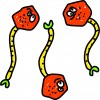 Listeriosis is one of several foodborne diseases that are often reported in the scientific and popular press. In the United States, it affects about 1,600 people every year, with about 270 of those cases resulting in death. It expresses itself in the affected person by means of septicemia, meningitis, and/or encephalitis. Pregnant women who have intrauterine or cervical infections caused by L. monocytogenes in their second or third trimesters may spontaneously abort the fetus or produce a stillbirth. Influenza-type symptoms, which may include continuous fever, usually precede the aforementioned disorders. This 4-page fact sheet was written by Keith R. Schneider, Renée Goodrich-Schneider, Michael A. Hubbard, and Susanna Richardson, and published by the UF Department of Food Science and Human Nutrition, March 2013.
Listeriosis is one of several foodborne diseases that are often reported in the scientific and popular press. In the United States, it affects about 1,600 people every year, with about 270 of those cases resulting in death. It expresses itself in the affected person by means of septicemia, meningitis, and/or encephalitis. Pregnant women who have intrauterine or cervical infections caused by L. monocytogenes in their second or third trimesters may spontaneously abort the fetus or produce a stillbirth. Influenza-type symptoms, which may include continuous fever, usually precede the aforementioned disorders. This 4-page fact sheet was written by Keith R. Schneider, Renée Goodrich-Schneider, Michael A. Hubbard, and Susanna Richardson, and published by the UF Department of Food Science and Human Nutrition, March 2013.
http://edis.ifas.ufl.edu/fs102
Bagworm, Thyridopteryx ephemeraeformis Haworth (Insecta: Lepidoptera: Psychidae) (EENY548/IN981)
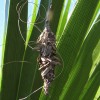 North American bagworm can feed on over 50 families of deciduous and evergreen trees and shrubs. Severe infestations can damage the aesthetics and health of host plants, especially juniper and arborvitae species. Many of the preferred host plants do not grow well below the USDA hardiness zone 8A, but due to its wide host range, high female fecundity, and method of dispersal, bagworm can still be problematic in the Florida landscape. This 5-page fact sheet was written by Brooke L. Moffis and Steven P. Arthurs, and published by the UF Department of Entomology and Nematology, March 2013.
North American bagworm can feed on over 50 families of deciduous and evergreen trees and shrubs. Severe infestations can damage the aesthetics and health of host plants, especially juniper and arborvitae species. Many of the preferred host plants do not grow well below the USDA hardiness zone 8A, but due to its wide host range, high female fecundity, and method of dispersal, bagworm can still be problematic in the Florida landscape. This 5-page fact sheet was written by Brooke L. Moffis and Steven P. Arthurs, and published by the UF Department of Entomology and Nematology, March 2013.
http://edis.ifas.ufl.edu/in981
Raising Healthy Children: Health Risks of Obesity (FCS80023/FY1356)
 Although babies need fat for warmth and normal growth, as children develop, too much fat can be unhealthy. Childhood obesity may result in health problems early in life and into adulthood. This 4-page fact sheet will help you understand the health risks of obesity and ways to help your child maintain a healthy weight. Written by Stephanie Meyer, Karla Shelnutt, and Gail Kauwell, and published by the UF Department of Family Youth and Community Sciences, April 2013.
Although babies need fat for warmth and normal growth, as children develop, too much fat can be unhealthy. Childhood obesity may result in health problems early in life and into adulthood. This 4-page fact sheet will help you understand the health risks of obesity and ways to help your child maintain a healthy weight. Written by Stephanie Meyer, Karla Shelnutt, and Gail Kauwell, and published by the UF Department of Family Youth and Community Sciences, April 2013.
http://edis.ifas.ufl.edu/fy1356
Carbohydrate Counting: Meals for Diabetes (FSHN1218/FS212)
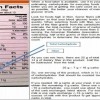 “Carb” counting is a way to plan meals to help you maintain target blood glucose levels. Certain foods contain carbohydrate, and these are the foods that most influence your blood glucose. Your body needs carbohydrate in just the right amount. Not enough carbohydrate can lead to low blood glucose (hypoglycemia). Too much carbohydrate can lead to high blood glucose (hyperglycemia). This is why carb counting is a great tool to understand and practice because it can help you control your blood glucose and still give you the freedom to make varied food choices. This 4-page fact sheet was written by Cassie Rowe, Jamila R. Lepore, and Wendy J. Dahl, and published by the UF Department of Food Science and Human Nutrition, March 2013.
“Carb” counting is a way to plan meals to help you maintain target blood glucose levels. Certain foods contain carbohydrate, and these are the foods that most influence your blood glucose. Your body needs carbohydrate in just the right amount. Not enough carbohydrate can lead to low blood glucose (hypoglycemia). Too much carbohydrate can lead to high blood glucose (hyperglycemia). This is why carb counting is a great tool to understand and practice because it can help you control your blood glucose and still give you the freedom to make varied food choices. This 4-page fact sheet was written by Cassie Rowe, Jamila R. Lepore, and Wendy J. Dahl, and published by the UF Department of Food Science and Human Nutrition, March 2013.
http://edis.ifas.ufl.edu/fs212
Pureed Foods: High Protein (FSHN1215/FS208)
 Protein is an important nutrient. Many older adults do not consume enough of this vital nutrient, crucial to overall health and well-being. For those with dysphagia and on a puréed diet, consuming sufficient protein is even more difficult. While a texture-modified diet may not be the diet of choice, the goal is to make it as appealing as possible so that the person consuming the purées can experience a better quality of life. This 4-page fact sheet was written by Jamila R. Lepore and Wendy J. Dahl, and published by the UF Department of Food Science and Human Nutrition, March 2013.
Protein is an important nutrient. Many older adults do not consume enough of this vital nutrient, crucial to overall health and well-being. For those with dysphagia and on a puréed diet, consuming sufficient protein is even more difficult. While a texture-modified diet may not be the diet of choice, the goal is to make it as appealing as possible so that the person consuming the purées can experience a better quality of life. This 4-page fact sheet was written by Jamila R. Lepore and Wendy J. Dahl, and published by the UF Department of Food Science and Human Nutrition, March 2013.
http://edis.ifas.ufl.edu/fs208
Promoting Healthy Relationship Development in Teens, Part I: How Dating Smart in Youth Can Foster Better Relationships in Adulthood (FCS2325/FY1363)
 Cultivating healthy dating relationships that can lead to healthy adult romantic and marriage relationships is a science that reflects a complicated calculus of the premarital influences that may shape future relationship stability, quality, and satisfaction. This 4-page fact sheet was written by Victor W. Harris, Gilon Marts, and Martie Gillen, and published by the UF Department of Family Youth and Community Sciences, March 2013.
Cultivating healthy dating relationships that can lead to healthy adult romantic and marriage relationships is a science that reflects a complicated calculus of the premarital influences that may shape future relationship stability, quality, and satisfaction. This 4-page fact sheet was written by Victor W. Harris, Gilon Marts, and Martie Gillen, and published by the UF Department of Family Youth and Community Sciences, March 2013.
http://edis.ifas.ufl.edu/fy1363
Reducing Fumigant Application Rates and Soil Emissions with Plastic Mulch Technology (ENY046/IN403)
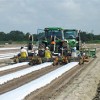 With the new fumigant regulations and rising cost of crop production, including fumigants, it would be desirable to reduce the standard use rate of soil fumigants. The use of higher-barrier, gas-impermeable mulches may make it possible to reduce fumigant application rates by helping to contain the fumigant longer within the soil and reduce overall emissions into the atmosphere. The results of field studies show that fumigant application rates can be reduced by 20 to as much as 40% through the use of virtually impermeable or the more gas-tight TIF mulch films at the time of application. This 5-page fact sheet was written by J. W. Noling, and published by the UF Department of Entomology and Nematology, March 2013.
With the new fumigant regulations and rising cost of crop production, including fumigants, it would be desirable to reduce the standard use rate of soil fumigants. The use of higher-barrier, gas-impermeable mulches may make it possible to reduce fumigant application rates by helping to contain the fumigant longer within the soil and reduce overall emissions into the atmosphere. The results of field studies show that fumigant application rates can be reduced by 20 to as much as 40% through the use of virtually impermeable or the more gas-tight TIF mulch films at the time of application. This 5-page fact sheet was written by J. W. Noling, and published by the UF Department of Entomology and Nematology, March 2013.
http://edis.ifas.ufl.edu/in403
Effect of Age at Castration on Beef Calf Performance (AN289)
 A study in Florida was conducted to examine the issue of age at castration to determine if castration timing resulted in significant differences in growth rate and weaning weight in nursing calves. In addition, the study included a comparison between Angus and Brangus calves in the treatment groups to determine if there was a breed by castration effect. No differences in calf growth rates were observed in early compared to late castration. This 4-page fact sheet was written by Amie Imler, Todd Thrift, Matt Hersom, and Joel Yelich, and published by the UF Department of Animal Sciences, March 2013.
A study in Florida was conducted to examine the issue of age at castration to determine if castration timing resulted in significant differences in growth rate and weaning weight in nursing calves. In addition, the study included a comparison between Angus and Brangus calves in the treatment groups to determine if there was a breed by castration effect. No differences in calf growth rates were observed in early compared to late castration. This 4-page fact sheet was written by Amie Imler, Todd Thrift, Matt Hersom, and Joel Yelich, and published by the UF Department of Animal Sciences, March 2013.
http://edis.ifas.ufl.edu/an289
Recommended Native Landscape Plants for Florida's Treasure Coast (ENH1082/EP348)
 This 17-page fact sheet provides useful resources and handy tables for information on the function, form, and landscape use of proven native performers of the Florida Treasure Coast (Martin, St. Lucie, and Indian River Counties). Written by Sandra B. Wilson, Judith A. Gersony, Keona L. Nolan, Janice C. Broda, and Edward A. Skvarch, Jr., and published by the UF Department of Environmental Horticulture, March 2013.
This 17-page fact sheet provides useful resources and handy tables for information on the function, form, and landscape use of proven native performers of the Florida Treasure Coast (Martin, St. Lucie, and Indian River Counties). Written by Sandra B. Wilson, Judith A. Gersony, Keona L. Nolan, Janice C. Broda, and Edward A. Skvarch, Jr., and published by the UF Department of Environmental Horticulture, March 2013.
http://edis.ifas.ufl.edu/ep348
Allelopathy: How Plants Suppress Other Plants (HS944/HS186)
 Allelopathy refers to the beneficial or harmful effects of one plant on another plant, both crop and weed species, from the release of biochemicals, known as allelochemicals, from plant parts by leaching, root exudation, volatilization, residue decomposition, and other processes in both natural and agricultural systems. This 5-page fact sheet introduces the concept of allelopathy and mentions potential applications as an alternative weed management strategy. Written by James J. Ferguson, Bala Rathinasabapathi, and Carlene A. Chase, and published by the UF Department of Horticultural Sciences, March 2013.
Allelopathy refers to the beneficial or harmful effects of one plant on another plant, both crop and weed species, from the release of biochemicals, known as allelochemicals, from plant parts by leaching, root exudation, volatilization, residue decomposition, and other processes in both natural and agricultural systems. This 5-page fact sheet introduces the concept of allelopathy and mentions potential applications as an alternative weed management strategy. Written by James J. Ferguson, Bala Rathinasabapathi, and Carlene A. Chase, and published by the UF Department of Horticultural Sciences, March 2013.
http://edis.ifas.ufl.edu/hs186
Energy Valuation Methods for Biofuels in South Florida: Introduction to Life Cycle Assessment and Emergy Approaches (SL377/SS579)
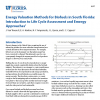 This 5-page fact sheet gives an overview of two methods for evaluating energy transformations in biofuels production. The Life Cycle Assessment approach involves measurements affecting greenhouse gases, which can be linked to the energy considerations used in the Emergy Assessment. Although these two methods have their basis in energy or greenhouse gas emission evaluations, their approaches can lead to a reliable judgment regarding a biofuel process. We can use them to evaluate the economic environmental component of a biofuel process, and decide which biofuel processes favor sustainability. The intended audiences of this publication are growers, researchers, students, and any other readers interested in agriculture and ecology. Written by J. Van Treese II, E. A. Hanlon, N. Y. Amponsah, J. L. Izursa, and J. C. Capece, and published by the UF Department of Soil and Water Science, March 2013.
This 5-page fact sheet gives an overview of two methods for evaluating energy transformations in biofuels production. The Life Cycle Assessment approach involves measurements affecting greenhouse gases, which can be linked to the energy considerations used in the Emergy Assessment. Although these two methods have their basis in energy or greenhouse gas emission evaluations, their approaches can lead to a reliable judgment regarding a biofuel process. We can use them to evaluate the economic environmental component of a biofuel process, and decide which biofuel processes favor sustainability. The intended audiences of this publication are growers, researchers, students, and any other readers interested in agriculture and ecology. Written by J. Van Treese II, E. A. Hanlon, N. Y. Amponsah, J. L. Izursa, and J. C. Capece, and published by the UF Department of Soil and Water Science, March 2013.
http://edis.ifas.ufl.edu/ss579
Storage Limitation Statements: Temperature – Fungicides (PI122/PI159)
 This 7-page fact sheet provides information about how temperature affects storage of agricultural fungicides. A table is included that lists many common agricultural fungicides registered for use in Florida along with storage limitations. was written by Frederick M. Fishel, and published by the UF Department of Agronomy, March 2013.
This 7-page fact sheet provides information about how temperature affects storage of agricultural fungicides. A table is included that lists many common agricultural fungicides registered for use in Florida along with storage limitations. was written by Frederick M. Fishel, and published by the UF Department of Agronomy, March 2013.
http://edis.ifas.ufl.edu/pi159
Fumigant Nematicides Registered for Vegetable Crop Use in Florida (ENY064/IN980)
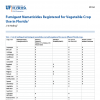 This 3-page fact sheet lists of multispectrum fumigant nematicides currently registered for use on different Florida crops (Table 1); their maximum rates and specific details for field application (Table 2); and a generalized summary of maximum use rate and relative effectiveness of various soil fumigants for nematode, soilborne disease, and weed control in Florida (Table 3). Written by J. W. Noling, and published by the UF Department of Entomology and Nematology, January 2013.
This 3-page fact sheet lists of multispectrum fumigant nematicides currently registered for use on different Florida crops (Table 1); their maximum rates and specific details for field application (Table 2); and a generalized summary of maximum use rate and relative effectiveness of various soil fumigants for nematode, soilborne disease, and weed control in Florida (Table 3). Written by J. W. Noling, and published by the UF Department of Entomology and Nematology, January 2013.
http://edis.ifas.ufl.edu/in980
What Is a Healthy Dating or Marriage Relationship? (FCS2323/FY1361)
 Defining what a healthy romantic relationship is can be challenging. Thankfully, modern research has given us a good idea of what healthy dating and marriage relationships look like. Use this fact sheet to determine what a healthy relationship looks like to you. Then take the survey to get an idea of the strengths already present in your relationship and those things you may want to work on. This 3-page fact sheet was written by Victor W. Harris, and published by the UF Department of Family Youth and Community Sciences, March 2013.
Defining what a healthy romantic relationship is can be challenging. Thankfully, modern research has given us a good idea of what healthy dating and marriage relationships look like. Use this fact sheet to determine what a healthy relationship looks like to you. Then take the survey to get an idea of the strengths already present in your relationship and those things you may want to work on. This 3-page fact sheet was written by Victor W. Harris, and published by the UF Department of Family Youth and Community Sciences, March 2013.
http://edis.ifas.ufl.edu/fy1361
De compras para la salud: Sodio (FSHN1006S/FS211)
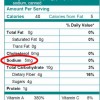 El sodio es un mineral que se encuentra en la sal de mesa. Es necesario para mantener un balance de fluidos y el volumen de sangre. El consumo excesivo de sodio puede causar presión alta en la sangre e incrementar el riesgo de enfermedades del corazón y derrames cerebrales. This 4-page fact sheet was written by Wendy J. Dahl y Lauren Foster, and published by the UF Department of Food Science and Human Nutrition, March 2013.
El sodio es un mineral que se encuentra en la sal de mesa. Es necesario para mantener un balance de fluidos y el volumen de sangre. El consumo excesivo de sodio puede causar presión alta en la sangre e incrementar el riesgo de enfermedades del corazón y derrames cerebrales. This 4-page fact sheet was written by Wendy J. Dahl y Lauren Foster, and published by the UF Department of Food Science and Human Nutrition, March 2013.
http://edis.ifas.ufl.edu/fs211
Preparation of Pureed Foods (FSHN1212/FS205)
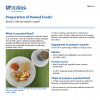 A puréed food is a food item that has been blended, mixed, or processed into a smooth and uniform texture. Examples of foods with a purée consistency include applesauce, pumpkin pie filling, and hummus. Puréed foods may be necessary for people with chewing and/or swallowing problems. For those requiring a puréed diet, it is important to provide a variety of foods. Almost any food can be puréed. However, some puréed foods may be much more acceptable than others. This 4-page fact sheet was written by Wendy J. Dahl and Jamila R. Lepore, and published by the UF Department of Food Science and Human Nutrition, March 2013.
A puréed food is a food item that has been blended, mixed, or processed into a smooth and uniform texture. Examples of foods with a purée consistency include applesauce, pumpkin pie filling, and hummus. Puréed foods may be necessary for people with chewing and/or swallowing problems. For those requiring a puréed diet, it is important to provide a variety of foods. Almost any food can be puréed. However, some puréed foods may be much more acceptable than others. This 4-page fact sheet was written by Wendy J. Dahl and Jamila R. Lepore, and published by the UF Department of Food Science and Human Nutrition, March 2013.
http://edis.ifas.ufl.edu/fs205
Is Our Food Safe from Pesticides? (PI230)
 Growers of the food supply have adopted the use of integrated pest management (IPM) because it is no longer possible to rely solely on chemical pesticides to prevent unacceptable crop losses. According to the U.S. Environmental Protection Agency (EPA), IPM is the coordinated use of pest and environmental information and available pest control methods to prevent unacceptable levels of damage by the most economical means with the least possible hazard to people, property, and the environment. Scientific IPM strategies give the grower economic incentives for sustaining long-term crop protection with minimal disruption to the environment. The agricultural community typically will use pesticides sparingly as part of the IPM strategy whenever proven alternatives are not available for pest control. This 4-page fact sheet was written by Frederick M. Fishel, and published by the UF Department of Agronomy, March 2013.
Growers of the food supply have adopted the use of integrated pest management (IPM) because it is no longer possible to rely solely on chemical pesticides to prevent unacceptable crop losses. According to the U.S. Environmental Protection Agency (EPA), IPM is the coordinated use of pest and environmental information and available pest control methods to prevent unacceptable levels of damage by the most economical means with the least possible hazard to people, property, and the environment. Scientific IPM strategies give the grower economic incentives for sustaining long-term crop protection with minimal disruption to the environment. The agricultural community typically will use pesticides sparingly as part of the IPM strategy whenever proven alternatives are not available for pest control. This 4-page fact sheet was written by Frederick M. Fishel, and published by the UF Department of Agronomy, March 2013.
http://edis.ifas.ufl.edu/pi230
Thousand Cankers Disease: A Threat to Black Walnut in Florida (FOR308/FR376)
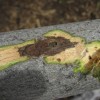 Thousand cankers disease of walnut is a tree disease of the edible nut-producing and ornamental tree, black walnut. The first diseased trees were observed in New Mexico in the 1990s. The disease has since spread to most of the western states. Until 2009, diseased black walnut trees were only found outside of the natural range of black walnut, which occurs from the mid-Atlantic states to just west of the Mississippi River. In 2009, it was found near Knoxville, Tennessee; it has since spread to Pennsylvania and Virginia. It is possible that within the next decade this disease could naturally spread to Florida. However, if people continue to move TCD infested walnut logs from place to place, this disease could arrive in Florida tomorrow. This 3-page fact sheet was written by Don Spence and Jason A. Smith, and published by the UF Department of School of Forest Resources and Conservation, February 2013.
Thousand cankers disease of walnut is a tree disease of the edible nut-producing and ornamental tree, black walnut. The first diseased trees were observed in New Mexico in the 1990s. The disease has since spread to most of the western states. Until 2009, diseased black walnut trees were only found outside of the natural range of black walnut, which occurs from the mid-Atlantic states to just west of the Mississippi River. In 2009, it was found near Knoxville, Tennessee; it has since spread to Pennsylvania and Virginia. It is possible that within the next decade this disease could naturally spread to Florida. However, if people continue to move TCD infested walnut logs from place to place, this disease could arrive in Florida tomorrow. This 3-page fact sheet was written by Don Spence and Jason A. Smith, and published by the UF Department of School of Forest Resources and Conservation, February 2013.
http://edis.ifas.ufl.edu/fr376
Women and Money: Unique Issues: Money and the Family (FCS7250/FY1354)
 Ask any parent and he or she will tell you — it costs money to raise children. Taking into account inflation, a middle-income family may spend more than $295,000 to raise a child born in 2011 to the age of 17. This is not a small amount of money, so you will need to know the types of expenses required to raise your family. This 5-page fact sheet reviews the costs associated with raising children and gives you tips on how to teach your children about finances. By knowing the costs of raising your family and setting up a budget, you can teach your children money management skills that will help them throughout their lives. Written by Lynda Spence, Martie Gillen, and Diann Douglas, and published by the UF Department of Family Youth and Community Sciences, March 2013.
Ask any parent and he or she will tell you — it costs money to raise children. Taking into account inflation, a middle-income family may spend more than $295,000 to raise a child born in 2011 to the age of 17. This is not a small amount of money, so you will need to know the types of expenses required to raise your family. This 5-page fact sheet reviews the costs associated with raising children and gives you tips on how to teach your children about finances. By knowing the costs of raising your family and setting up a budget, you can teach your children money management skills that will help them throughout their lives. Written by Lynda Spence, Martie Gillen, and Diann Douglas, and published by the UF Department of Family Youth and Community Sciences, March 2013.
http://edis.ifas.ufl.edu/fy1354